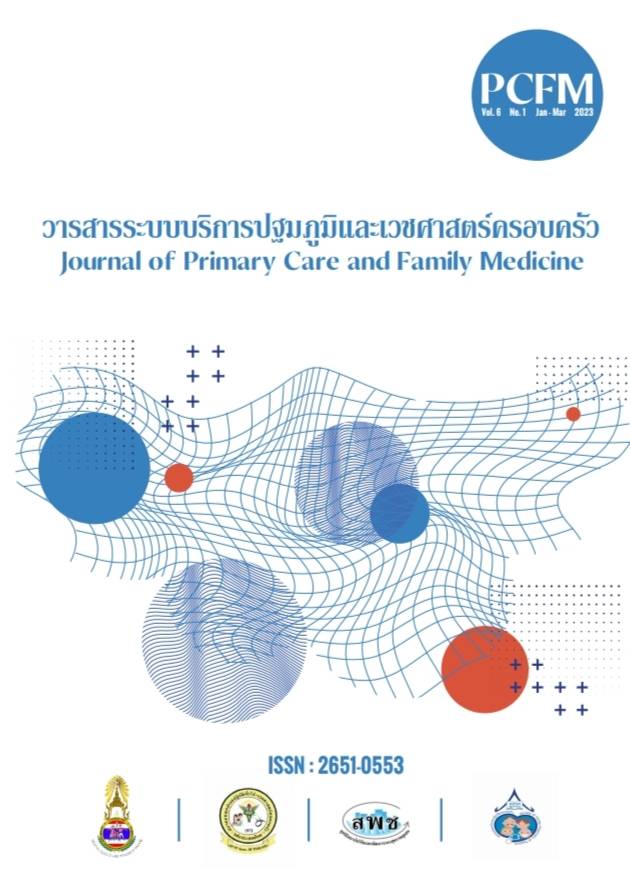ปัจจัยทำนายคุณภาพชีวิตด้านสุขภาพของผู้ป่วยโรคเกาต์ในจังหวัดนครราชสีมา
Main Article Content
บทคัดย่อ
ความเป็นมาและวัตถุประสงค์: คุณภาพชีวิตด้านสุขภาพเป็นผลลัพธ์ทางสุขภาพที่สำคัญของผู้ป่วยโรคเกาต์ การวิจัยนี้มีวัตถุประสงค์เพื่อศึกษาปัจจัยทำนายคุณภาพชีวิตด้านสุขภาพของผู้ป่วยโรคเกาต์ในจังหวัดนครราชสีมา
วิธีการวิจัย: การศึกษาเชิงทำนาย กลุ่มตัวอย่างคือผู้ป่วยโรคเกาต์ที่รับบริการในโรงพยาบาลส่งเสริมสุขภาพตำบล จังหวัดนครราชสีมา จำนวน 130 คน เลือกกลุ่มตัวอย่างโดยวิธีการสุ่มอย่างง่าย เก็บข้อมูลโดยใช้แบบสอบถาม วิเคราะห์ข้อมูลโดยใช้สถิติเชิงบรรยาย และการวิเคราะห์การถดถอยเชิงพหุคูณ
ผลการศึกษา: คุณภาพชีวิตด้านสุขภาพของกลุ่มตัวอย่างอยู่ในระดับสูง (M = 69.95, SD = 15.43) ปัจจัยทำนายคุณภาพชีวิตด้านสุขภาพของผู้ป่วยโรคเกาต์ ได้แก่ อาการปวด (Beta = -.46) การสนับสนุนทางสังคม (Beta = .32) ภาวะการทำหน้าที่ (Beta = .27) และอายุ (Beta = -.12) สามารถร่วมกันทำนายคุณภาพชีวิตด้านสุขภาพของผู้ป่วยโรคเกาต์ได้ร้อยละ 60. 50 อย่างมีนัยสำคัญทางสถิติที่ระดับ .05 สำหรับปัจจัยการกำเริบของโรคเกาต์ ความเข้มแข็งในการมองโลก และความเครียดไม่สามารถทำนายคุณภาพชีวิตด้านสุขภาพของผู้ป่วยโรคเกาต์ได้
สรุป: บุคลากรทางการแพทย์ควรส่งเสริมให้ผู้ป่วยโรคเกาต์มีคุณภาพชีวิตด้านสุขภาพอยู่ในระดับสูงต่อไป โดยบูรณาการที่ค้นพบมาใช้ในการประเมิน วางแผน และดูแลรักษา เช่น การสอนแนะวิธีการจัดการกับอาการปวดด้วยการใช้ยาและการไม่ใช้ยา การเปิดโอกาสให้สมาชิกในครอบครัวมีส่วนร่วมในการดูแล และการส่งเสริมให้ผู้ป่วยปฏิบัติกิจวัตรประจำวันด้วยตนเองให้มากที่สุดตามความเหมาะสมของวัย
Article Details

อนุญาตภายใต้เงื่อนไข Creative Commons Attribution-NonCommercial-NoDerivatives 4.0 International License.
เนื้อหาและข้อมูลในบทความที่ลงตีพิมพ์ในวารสาร PCFM ถือเป็นข้อคิดเห็นและความรับผิดชอบของผู้เขียนบทความโดยตรง ซึ่งกองบรรณาธิการวารสารไม่จำเป็นต้องเห็นด้วยหรือร่วมรับผิดชอบใด ๆ
บทความ ข้อมูล เนื้อหา รูปภาพ ฯลฯ ที่ได้รับการตีพิมพ์ลงในวารสาร PCFM ถือเป็นลิขสิทธิ์ของวารสาร PCFM หากบุคคลหรือหน่วยงานใดต้องการนำทั้งหมดหรือส่วนหนึ่งส่วนใดไปเผยแพร่ต่อหรือเพื่อกระทำการใด ๆ จะต้องได้รับอนุญาตเป็นลายลักษณ์อักษรจากวารสาร PCFM ก่อนเท่านั้น
เอกสารอ้างอิง
Dehlin M, Jacobsson L, & Roddy E. Global epidemiology of gout: prevalence, incidence, treatment patterns and risk factors. Nat Rev Rheumatol 2020: 16(7): 380-390.
Srisansanee P. Clinical features of patients with normouricemia during acute gouty attack. MJSSBH 2017; 32(2): 55-67.
Chandratre P, Mallen C, Richardson J, Muller S, Hider S, Rome K, ... & Roddy E. Health-related quality of life in gout in primary care: baseline findings from a cohort study. Semin Arthritis Rheum 2018; 48(1): 61-69.
Wilson I, and Cleary, P. Linking clinical variables with HRQOL: a conceptual model of outcomes. J Am Heart Assoc 1995; 273(1): 59–65.
Fu T, Cao H, Yin R, Zhang L, Zhang Q, Li L, & Gu Z. Associated factors with functional disability and health-related quality of life in Chinese patients with gout: a case-control study. BMC Musculoskelet Disord 2017; 18(1): 1-10.
Oumtanee, P. & Jitpanya, C. Relationships between joint pain, passive pain coping, sleep quality and health-related quality of life in patients with gout. HCU J Health Sci 2020; 24(1): 63-74.
Antonovsky A. Unraveling the mystery of health: how people manage stress and stay well. 4th ed. San Francisco: Jossey-Bass; 1987.
Hanucharurnkul, S. Intarasombat, P. & Putwatana, P. Daily distractions, sense of coherence, well-being perception among nurse educators in university. Thai J Nurs 1989; 3: 169-190.
Mahatnirunkul, S. Pumpaisalchai, W. & Tapanya, P. The construction of Suan Prung stress test for Thai population. Bulletin Of Suanprung 1998; 13(3): 1-20.
Zimet G, Powell S, Farley G, Werkman S, & Berkoff K. Psychometric characteristics of the multidimensional scale of perceived social support. J Pers Assess 1990; 55(4): 610-617.
Wongpakaran N, & Wongpakaran T. A revised Thai multi-dimensional scale of perceived social support. Span J Psychol 2012; 15(3): 1503-1509.
Hirsch D, Lee J, Terkeltaub R, Khanna D, Singh J, Sarkin A, ... & Kavanaugh A. Evaluation of an instrument assessing influence of gout on health-related quality of life. J Rheumatol 2008; 35(12): 2406-2414.
Zhou W, Zhu J, Guo J, Chen H, Zhang X, Gu Z, ... & Dong C. Health-related quality of life assessed by Gout Impact Scale (GIS) in Chinese patients with gout. Curr Med Res Opin 2020; 36(12): 2071-2078.
Shen B, Chen H, Yang D, Yolanda O, Yuan C, Du A,….. & Xu G-Y. A structural equation model of health-related quality of life in Chinese patients with rheumatoid arthritis. Front. Psychiatry 2021; 12: 716996.
Kang G, & Lee N. (2020). Development and evaluation of a self‐management application for patients with gout. Jpn J Nurs Sci 2020; 17(2): e12285.


